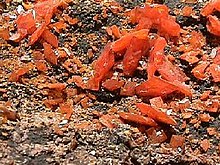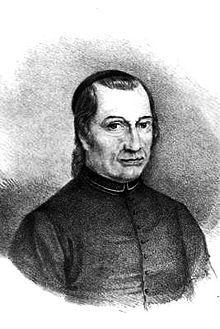Franz Xaver von Wulfen
Franz Xaver Freiherr von Wulfen (born November 5, 1728 in Belgrade , † March 16, 1805 in Klagenfurt ) was a Jesuit , botanist and mineralogist . He is known as the discoverer of the Carinthian wulfenia and the yellow lead ore wulfenite . Its official botanical author's abbreviation is " Wulfen ".
Life

Wulfen was born in Belgrade as the son of Lieutenant Field Marshal Christian Friedrich von Wulffen.
After his training in Kosice (then Hungary) he joined the Jesuit order in 1745. He studied philosophy, mathematics and theology. He worked as a teacher from 1755: 1755 in Görz, from 1756 at the Theresian Knight Academy in Vienna, 1761 in Görz, from 1762 in Ljubljana. In 1763 he took the religious vows. From 1764 he worked at the Klagenfurt Jesuit College , where he taught physics and mathematics. From 1769 he was only active as a pastor. After the end of his teaching activities and especially after the abolition of the Jesuit order in 1773, he devoted himself to scientific research, especially botany and mineralogy . In 1797 a large part of his collections was stolen from him by the French occupiers.
In 1799 and 1800 Wulfen took part in Prince Bishop Salm's expedition to climb the Grossglockner for the first time .
Wulfen was a member of the academies and scientific societies of Berlin, Erlangen, Jena, Göttingen, Klagenfurt and Stockholm. In 1790 he was elected a member of the German Academy of Sciences Leopoldina .
Nikolaus Joseph Freiherr von Jacquin and Johann Christian Daniel Schreber were among his many correspondence partners .
Scientific research

Wulfenite , first described by Wulfen
|

Sticky primrose , (Primula glutinosa)
|

Wulfen houseleek , (Sempervivum wulfenii)
|
Wolfen's main research area was the Eastern Alps, whose mountain and valley flora he researched intensively. He described several new plant species, both flowering plants and cryptogams , especially lichens . Research trips often took him to the Adriatic , but also to Holland.
Another area of research was mineralogy . The yellow lead ore he discovered was named wulfenite in his honor in 1841 and he was the first to describe the opalescent Bleiberger shell marble .
- The alpine plants first described by Wulfen include:
- Kärntner Kuhtritt or Wulfenie 1779, named Wulfenia carinthiaca in his honor by Nicolas Jacquin .
- Carniolan bellflower ( Campanula zoysii ), 1788, in honor of the Carnic botanist Carl Zois .
- Sticky primrose ( Primula glutinosa )
- Musk saxifrage ( Saxifraga moschata )
- Lashed man's shield ( Androsace chamaejasme )
- Musk yarrow ( Achillea moschata )
-
Algae from the Adriatic:
- Ulva stellata , now Anadyomene stellata (Wulfen) C. Agardh
- Fucus musciformis , now Hypnea musciformis (Wulfen) JVLamour
- Fucus filamentosus , now Spyridia filamentosa (Wulfen) Harv.
- Fucus simplex , now Digenea simplex (Wulfen) C. Agardh
Honors
In his honor the genus Wulfenia ( Wulfenia ) Jacq. the plant family of the plantain family (Plantaginaceae). The Wulfen houseleek (by Hoppe) and Wulfen's Mannsschild were named after him. The genus Wulfeniopsis D.Y.Hong is named after him. A bust of Franz Xaver von Wolfen stands in front of the Europagymnasium, the successor institution of the Lyceum, in Klagenfurt. In addition, a street in Klagenfurt, starting from the Viktringer Ring, was named after him.
Fonts
- Plantae rariores carinthiacae . In: Miscellanea austriaca ad botanicam, chemiam et historiam naturalem spectantia, ed. by NJ Jacquin, Vol. 1 (1778) pp. 147-163 and Vol. 2 (1781) pp. 25-183.
- Treatise on the Carinthian lead spade , 1785
- Plantae rariores carinthiacae . In: Collectanea as botanicam, chemiam et historiam naturalem, ed. by NJ Jacquin, Vol. I (1786) pp. 186–364, Vol. II (1788) pp. 112–234, Vol. III (1789) pp. 3–166, Vol. IV (1790) pp. 227– 348.
- Descriptiones Quorumdam Capensium Insectorum , 1786 ( digitized version )
- Plantae rariores descriptae , 1803
- Cryptogama aquatica , 1803
- Flora Norica phanerogama , 1858, posthumously ed. by Eduard Fenzl and Graf
supporting documents
- Marianne Klemun: Franz Xaver Freiherr von WULFEN - Jesuit and natural scientist. The first natural history survey in Carinthia. In: Carinthia II. 179/99, 1989, pp. 5-17 ( PDF on ZOBODAT ).
- Marianne Klemun: The edition history of the "Flora norica" Wulfens. In: Carinthia II. 179/99, 1989, pp. 19-28 ( PDF on ZOBODAT ).
- Marianne Klemun: On the scientific history of Carinthia. In: Carinthia II. 178/98, 1988, pp. 85-93 ( PDF on ZOBODAT ).
- Marianne Klemun: Working conditions of a natural scientist in Carinthia in the 18th century using the example of Franz Xaver Wulfens. In: Carinthia I. 174, 1984, pp. 357-374.
- Marianne Klemun, GH People: Franz Xaver Wulfens travel description from 1783 “On my journey to the highest peak of the Owir” . In: The Hochobir. From nature and history. Natural Science Association for Carinthia , Klagenfurt 1999, pp. 13–48.
- Marianne Klemun: Natural history, exchange and function of a scientific correspondence network. Franz Xaver Wulfens (1728–1805) letters to naturalists, especially to Johann Christian Daniel Schreber (1739–1810). In: Carinthia II. 195./115. Year, 2005, pp. 253–268 ( PDF on ZOBODAT ).
- Entry in Catholic Encyclopedia (English)
- Georgios Fatouros: WULFEN, Freiherr von, Franz Xavier. In: Biographisch-Bibliographisches Kirchenlexikon (BBKL). Volume 14, Bautz, Herzberg 1998, ISBN 3-88309-073-5 , Sp. 167-168.
further reading
- F. Arnold, In memory of Freiherrn von Wulfen , in: Negotiations of the zoolog. bot. Society, XXXII. Vienna 1882.
- Constantin von Wurzbach : Wulfen, Franz Xaver Freiherr . In: Biographisches Lexikon des Kaiserthums Oesterreich . 58th part. Kaiserlich-Königliche Hof- und Staatsdruckerei, Vienna 1889, pp. 265–269 ( digitized version ).
- Ernst Wunschmann: Wulfen, Franz Xaver Freiherr von . In: Allgemeine Deutsche Biographie (ADB). Volume 44, Duncker & Humblot, Leipzig 1898, p. 268 f.
- Marianne Klemun: Franz Xaver Freiherr von Wulfen - Jesuit and natural scientist. The first natural history survey in Carinthia. In: Carinthia II. 179/99. Year, 1989, pp. 5–17 ( PDF on ZOBODAT ).
- W. Honsig-Erlenburg, P. Mildner: Franz Xaver Freiherr von Wulfen as an ichthyologist. In: Carinthia II. 186./106. Year, 1996, pp. 349–360 ( PDF on ZOBODAT ).
- Michael von Kunitsch, biography of Franz Xaver Freiherr von Wulfen ( digitized version ).
Web links
- Author entry and list of the plant names described for Franz Xaver von Wulfen at the IPNI
- Biography of Michael J. Wynne's Website (English)
- Entry on Franz Xaver von Wulfen in the Austria Forum (in the AEIOU Austria Lexicon )
Individual evidence
- ^ Antonio Schmidt-Brentano: Imperial and Imperial Generals (1618-1815), Austrian State Archives 2006, p. 112
- ^ List of members Leopoldina, Franz Xaver Frhr. from Wulfen
- ↑ a b Lotte Burkhardt: Directory of eponymic plant names - extended edition. Part I and II. Botanic Garden and Botanical Museum Berlin , Freie Universität Berlin , Berlin 2018, ISBN 978-3-946292-26-5 doi: 10.3372 / epolist2018 .
| personal data | |
|---|---|
| SURNAME | Wulfen, Franz Xaver von |
| ALTERNATIVE NAMES | Wulfen, Franz Xaver Freiherr von; Wulfen, Franz Xavier von |
| BRIEF DESCRIPTION | Botanist and mineralogist |
| DATE OF BIRTH | November 5, 1728 |
| PLACE OF BIRTH | Belgrade |
| DATE OF DEATH | March 16, 1805 |
| Place of death | Klagenfurt |

